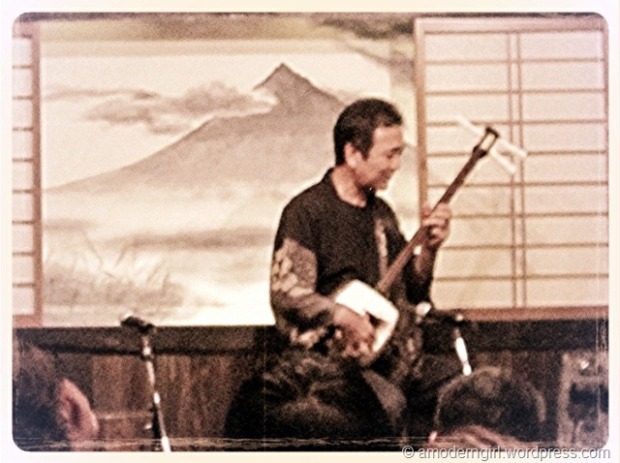A Modern Girl in the Japanese news!

Apparently, I’ve had a lot of new visitors lately! It turns out that my recent post on Tsugaru shamisen was featured on the Japanese-language website Searchina:
【米国ブログ】日本の三味線「独特の弦の響きとリズムに感動」
日本に滞在中の米国人女性が、日本文化に関する情報を提供するブログサイト「amoderngirl.wordpress」で、津軽三味線(つがるじゃみせん)について記した。
友人を訪ねて青森を旅行した筆者は、津軽三味線を聴く機会があった。三味線に馴染みのない筆者は、音色に興味を持った。「三本の弦で演奏される三味線はどこかで聴いたことのある音色」で、映画などで日本をイメージする曲で使われている気がするという。筆者にとって三味線は、「異国情緒溢れる音」だと述べる。
三味線に使われる革は、太鼓に似ている印象を持ったようだ。革は音楽のジャンルと弾き手の技量で異なるようで、一般には猫の腹を使用していたが、高価なため稽古用には犬の革を使用すると説明。さらに、糸も伝統的には絹糸を使うが、稽古用には長持ちして安価なナイロンを使用すると補足した。
三味線が最も特徴的なのは、独特の弦の響きとリズムで「西洋音楽に似たビートに心を打たれた」と感想を記した。津軽三味線は青森が発祥で、この地域の大小レストランで演奏がなされている。筆者が夕食を食べた店でも行われたようだ。「驚くほど素晴らしいパフォーマンスだった」と絶賛し、翌日もほかの店で演奏があったが、「なんと、小学生の子供が堂々と三味線を弾きこなしていた」と感動を伝えた。
「地元の店で日本文化の興味深い面を経験できてとてもラッキーだった」と語り、「もし三味線に興味があったら、ユーチューブで聴いてみてほしい」と推薦。日本人にとっては聞き慣れた三味線の音色も、外国人にとっては新鮮に聴こえるようだ。(編集担当:田島波留・山口幸治)
Here’s my very quick and awkward attempt to translate the article for my English-speaking readers–if you look at my original post, you’ll notice some differences in content:
Japanese Shamisen: Moved by the Unique Rhythm and Sound of the Strings
An American woman living in Japan writes about Tsugaru-jamisen in her informational blog about Japanese culture, “amoderngirl.wordpress.”
The author had a chance to hear Tsugaru-jamisen when she traveled to Aomori to visit a friend. Being unfamiliar with the sound of the shamisen, she was interested in its tone. She says that “the tone of the three-stringed shamisen, which you’ve probably heard before,” is used to bring to mind the image of Japan in movies and the like. For her, the shamisen is “the sound of the exotic.”
It seems that she has the impression that the leather used in the shamisen resembles a drum. She explains that the leather is different depending on the genre of music and the ability of the performer; generally, a cat’s stomach is used, but it is expensive, so a dog’s stomach is used for practice. Moreover, the strings were traditionally made of silk, but for practice, it is supplemented with durable and low-cost nylon.
The most characteristic thing about the shamisen is the unique sound of the strings and the rhythm, which she thinks “strike the heart in a beat similar to Western music.” In Aomori, the home of Tsugaru shamisen, performances are held in various local restaurants. It seems that there was even one at the restaurant where the author ate dinner. She praised it as a “performance so terrific I was surprised.” The next day there was another performance at a different shop, and she was impressed at “how an elementary school child could play so confidently.”
“I was very lucky to experience such an interesting aspect of Japanese culture at a local shop,” she says, “If you are interested in shamisen, please listen on YouTube.” It seems that the sound of the shamisen that is so familiar to Japanese people sounds fresh to foreigners.
And there you have it, real-life cultural exchange via the blogoverse! :)
Searchina did a similar article on my post on Traditional Kaiseki Cuisine at a Japanese Ryokan back in November 2011 as well. You can read the Japanese article here:
As always, thanks for stopping by! The holidays are almost upon us–I hope all of you are warm and happy this winter!
Related Posts:
- Welcome to the World of Tsugaru Shamisen
- Traditional Kaiseki Cuisine at a Japanese Ryokan
- Goodbye Lennon: Remembering the John Lennon Museum
- Places in Japan: One Fantastic Day in Historic Takayama

So cool! Congrats on the exposure. I love getting a glimpse at your life there.
Thanks! I always enjoy following your posts on Twitter. :)
This happened to me, too! Searchina decided I was a male tourist who was moved by my experiences at Foodpia. Could not have been more off the mark. I wish Searchina would put as much time into their translations as I do into my own. Not bitter at all.
Yikes, how annoying! I don’t blame you for being bitter.
Thanks for stopping by! I just subscribed to your blog–looks fun!
Congrats!
The same thing happened to me — at first I was super confused about where all the visitors came from, but then I saw that all the referrals were coming from Searchina. You inspired me to translate their article about my post to put on my blog. I’m also thinking of writing a short message in Japanese to put on that particular post that was covered, as a welcome to Japanese readers.
Again, おめでとう on the coverage!
Pingback: It’s Bloggiesta Time (Again)! | A Modern Girl / モダンガール
Pingback: A Modern Girl’s Year in Blogging: 2014 Edition | A Modern Girl / モダンガール